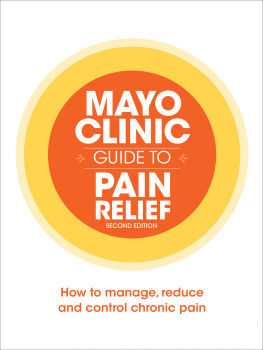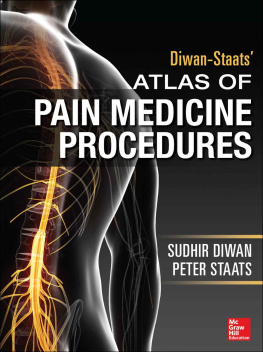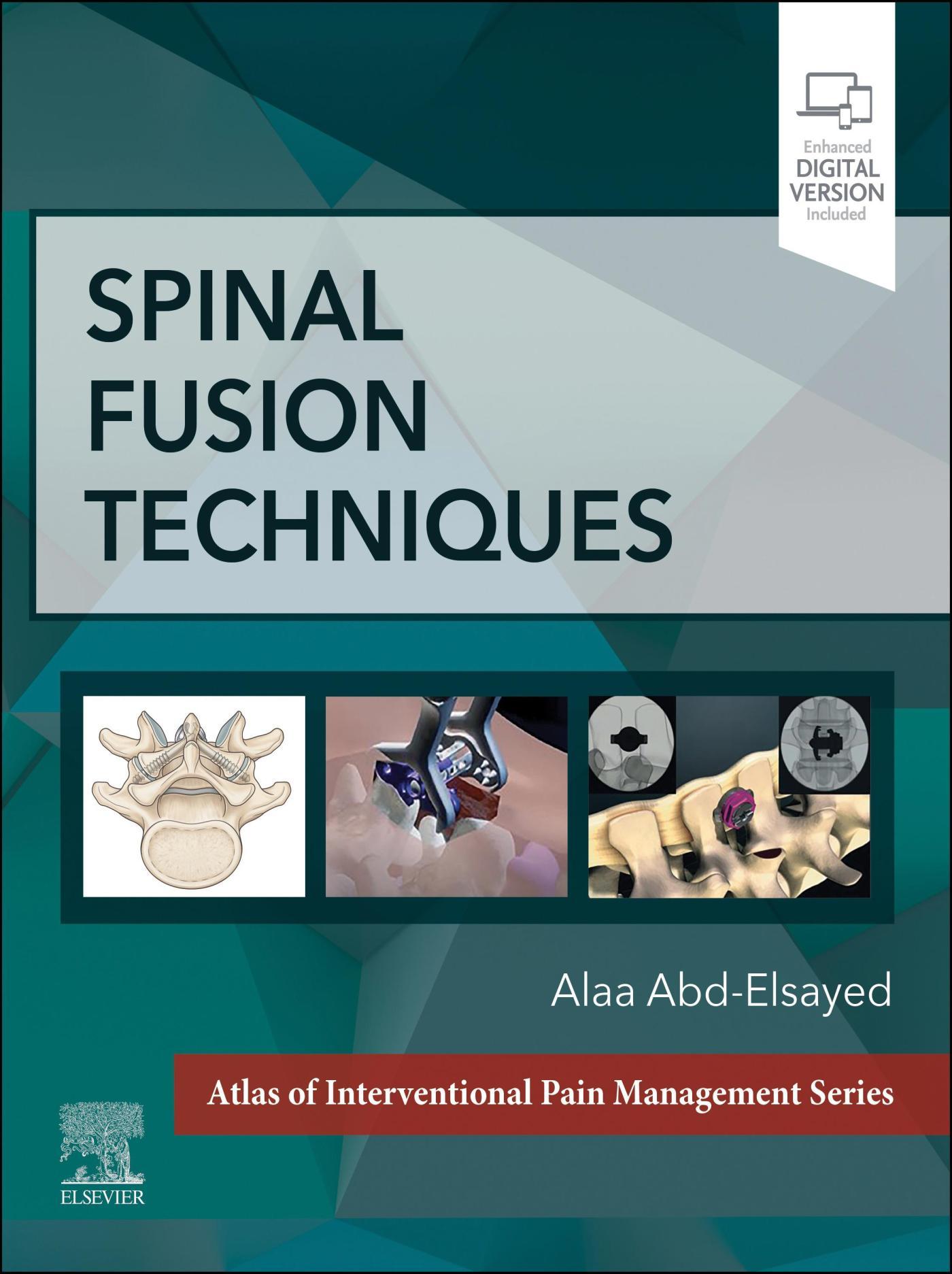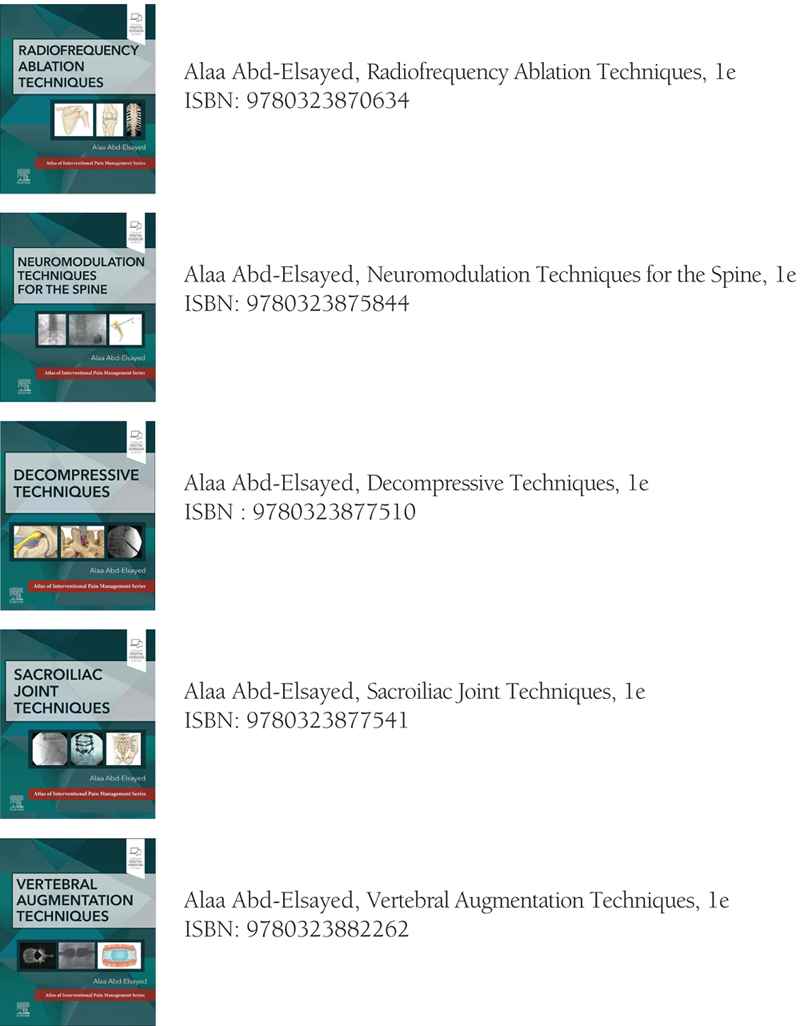Table of Contents
List of tables
- Tables in Chapter 1
- Tables in Chapter 2
- Tables in Chapter 6
List of figures
- Figures in Chapter 1
- Figures in Chapter 2
- Figures in Chapter 3
- Figures in Chapter 5
- Figures in Chapter 6
- Figures in Chapter 7
Landmarks
Spinal Fusion Techniques
Atlas of Interventional Pain Management Series
Alaa Abd-Elsayed, MD, MPH, CPE, FASA
Medical Director, UW Health Pain Services, Medical Director, UW Pain Clinic, Division Chief, Chronic Pain Management, Department of Anesthesiology, University of Wisconsin, Madison, Wisconsin, United States

Table of Contents
Other books in this series
Copyright
Elsevier
1600 John F. Kennedy Blvd.
Ste 1800
Philadelphia, PA 19103-2899
Spinal Fusion TechniquesISBN: 978-0-323-88223-1
Atlas of Interventional Pain Management Series
Copyright 2024 by Elsevier Inc. All rights reserved.
No part of this publication may be reproduced or transmitted in any form or by any means, electronic or mechanical, including photocopying, recording, or any information storage and retrieval system, without permission in writing from the publisher. Details on how to seek permission, further information about the Publishers permissions policies and our arrangements with organizations such as the Copyright Clearance Center and the Copyright Licensing Agency, can be found at our website: www.elsevier.com/permissions.
This book and the individual contributions contained in it are protected under copyright by the Publisher (other than as may be noted herein).
Notice
Practitioners and researchers must always rely on their own experience and knowledge in evaluating and using any information, methods, compounds or experiments described herein. Because of rapid advances in the medical sciences, in particular, independent verification of diagnoses and drug dosages should be made. To the fullest extent of the law, no responsibility is assumed by Elsevier, authors, editors or contributors for any injury and/or damage to persons or property as a matter of products liability, negligence or otherwise, or from any use or operation of any methods, products, instructions, or ideas contained in the material herein.
Senior Content Development Manager: Somodatta Roy Choudhury
Executive Content Strategist: Michael Houston
Senior Content Development Specialist: Malvika Shah
Publishing Services Manager: Shereen Jameel
Project Manager: Maria Shalini
Senior Designer: Patrick C. Ferguson
Printed in India
Last digit is the print number:987654321

Dedication
To my God, my parents, my wife, and my two beautiful kids Maro and George.
Contributors
Alaa Abd-Elsayed, MD, MPH, CPE, FASA , Medical Director, UW Health Pain Services, Medical Director, UW Pain Clinic, Division Chief, Chronic Pain Management, Department of Anesthesiology, University of Wisconsin, Madison, Wisconsin, United States
Chase Beal , Chase Beal, DO, Physician, Department of Physical Medicine and Rehabilitation MetroHealth System/Case Western Reserve University, Cleveland, OH, United States
Brian R. Brenner, MD , Physician, Department of Anesthesiology, University of Virginia, Charlottesville, VA, United States
Ryan Budwany, MD, MPH, MBA , Director of Pain Medicine, CAMC Teays Valley Hospital, Spine and Nerve Centers of the Virginias, Hurricane, WV, United States
Ryan Steven DSouza, MD , Pain Physician, Anesthesiology and Perioperative Medicine, Mayo Clinic Hospital, Rochester, MN USA
Jay Darji, DO , Physician, Temple University/Moss Rehabilitation, Philadelphia, PA, United States
Tyler Ericson, MD , Physician, Department of Anesthesiology, University of Virginia, Charlottesville, VA, United States
Steven M. Falowski, MD , Director Functional Neurosurgery, Neurosurgery, Neurosurgical Associates of Lancaster, Lancaster, PA, United States
Michael A. Fishman, MD, MBA , Interventional Pain Physician, Director of Research, Center for Interventional Pain and Spine, Lancaster, PA, United States
Mayank Gupta, MD
President and CEO, Kansas Pain Management and Neuroscience Research Center LLC, Overland Park, KS
Adjunct Clinical Assistant Professor, Kansas City University of Medicine and Biosciences President, Kansas Society of Interventional Pain Physicians, Kansas City, MO, United States
Michael Gyorfi, MD , Anesthesiology, University of Wisconsin School of Medicine and Public Health, Madison, WI, United States
Behnum Habibi, MD , Assistant Professor, Physical Medicine and Rehabilitation, Temple University Health System, Philadelphia, PA, United States
Jason Hamamoto, MD , Physician, Temple University/Moss Rehabilitation, Philadelphia, PA, United States
Chong Kim, MD , Professor, Department of Physical Medicine and Rehabilitation, MetroHealth System/Case Western Reserve University School of Medicine, Cleveland, OH, United States
Lynn Kohan, MD, MS , Professor of Anesthesiology and Pain Medicine, Department of Anesthesiology, Division of Pain Medicine, University of Virginia, Charlottesville, VA
Andrew Olsen, DO , Department of Physical Medicine and Rehabilitation, MetroHealth System/Case Western Reserve University School of Medicine, Cleveland, Ohio, United States
Priyanka Singla, MBBS, MD , Pain Medicine, Division of pain medicine, Department of Anesthesiology, University of Virginia, Charlottesville, VA, United States
Omar Viswanath, MD
Interventional Pain Medicine Physician, Anesthesiologist, Innovative Pain and Wellness, AZ;
Department of Anesthesiology, Creighton University School of Medicine, Omaha, NE;
Department of Anesthesiology, LSU Health Shreveport, Shreveport, LA, United States
Preface
Alaa Abd-Elsayed, MD, MPH, CPE, FASA
Minimally invasive spinal fusion procedures are an evolving modality for treating chronic pain. Importantly, the development of percutaneous fusion devices and techniques has made it feasible for the pain physician to safely perform these procedures. However, prior to performing these procedures, knowledge of neuroaxial anatomy, an understanding of the indications and contraindications, sound procedural technique, and an ability to identify and manage any potential complications is needed.
To further assist the pain physician in adopting these techniques into their practice, we authored this book to provide a detailed guide on currently known minimally invasive spinal fusion procedures. In each chapter we highlight important anatomic considerations, aspects for patient selection, perioperative considerations, and procedural techniques with images for various minimally invasive spinal fusion procedures.
In developing this book, I would first like to thank my fellow coauthors who spent countless hours in curating information and contributing to this initiative. I would also like to thank my family who continues to support me in my research endeavors. Finally, I would like to thank the publisher, who has provided me and my fellow coauthors with many opportunities to contribute to the medical literature.













